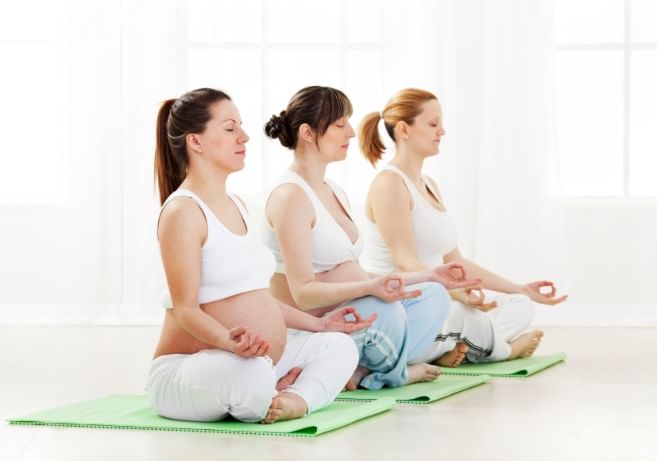Yoga During Pregnancy
How to start:
If you have been practising yoga already, you can continue during your pregnancy. However, if you are planning to start yoga as a form of exercise during pregnancy, it is ideal to do so in the second trimester. Yoga can be performed once a week or every day. The duration can range from 5 to 60 minutes per session. Follow these guidelines while practising yoga:
✓ Listen to your body carefully. If you feel any discomfort, stop. You will probably need to modify each pose as your body changes.
✓ Avoid lying on your back after the first trimester; it can reduce blood circulation to the uterus.
✓ Avoid poses that stretch the muscles too much. You are more at risk for strains, pulls and other injuries right now because of the pregnancy hormone relaxin, which softens and relaxes joints and connective tissue.
✓ From the second trimester – when your centre of gravity starts to shift – do all standing poses with your heel against the wall or use a chair for support, to avoid losing your balance and risking injury to yourself or your baby. Here is the most comprehensive second trimester dos and don’ts for you to follow.
✓ While twisting, move from the shoulders and back, rather than the waist, to avoid putting pressure on your abdomen. Twist only as far as it feels comfortable – deep twists are not advisable in pregnancy. Here are three simple exercises that can boost blood circulation during pregnancy.
1. Palm tree
Imagine you are a palm tree swaying in the wind.
Benefit: This pose stretches and strengthens the torso
Stand upright, raise your arms overhead and interlock your fingers.
Now stretch slowly and gently to the right and then the left, imitating the swaying movement of a palm tree.
2. Modified triangle pose
Can you position your body in such a way that it forms three triangles?
Benefit: This pose regulates the digestive system and massages internal organs like the liver.
Stand with your feet wide apart and arms extended at shoulder level parallel to the floor.
Stretch your left hand overhead and bend down to the right side and touch your knee. Look up at your left hand.
Return to starting position and switch sides.
3. Modified forward bend
Reach forward with your hands, with a chair for support.
Benefit: This pose stretches the back and legs.
Stand tall in front of a chair.
Lift your arms and reach towards the chair; press your palms on the chair. Keep your back straight and bend from your hips. Hold.
Return to standing position.
4. Seated twist
Twist to the right and then to the left, to improve the mobility of the spine.
Benefit: This pose stretches the spine, improves digestion and relieves constipation.
Sit with your legs stretched out in front of you. Bend your right knee and take the right foot over the left knee.
Bring the left arm and elbow over the right knee. Keep your right hand behind you on the fl oor for support. Now twist your torso to the right and turn your head back.
Return to starting position and switch sides.
5. Cat-camel pose
Imitate a cat and then a camel. Arch your spine like a cat and then lift it up like the hump of a camel.
Benefit: releases spinal stress
Get down on all fours on your mat. Place your hands directly below your shoulders. Now lift your tailbone up towards the ceiling so that your lower back is concave. As you do this your head will lift up naturally towards the ceiling.
Now round your back like the hump of a camel and roll your head towards your chest. Make the movements as fluid as possible.
6. Butterfly pose
Imitate a butterfly.
Benefit: Increases mobility of the hip joints and stretches the inner thigh.
Sit with your legs outstretched on the mat. Bend your knees and bring your feet in as close as possible, towards you. Bring the soles of your feet together.
Keep your spine straight and gently move your legs down and up, resembling the movement of a butterfly as it flaps its wings.
7. The modified corpse
You need to relax in order to feel rejuvenated.
Lie on your left side; place a pillow between your legs and below your head for support.
Close your eyes and relax your mind.
To make the poses more comfortable, use blankets, pillows, cushions and chairs for support if you need them. For instance, you can perform seated positions on a folded blanket. If maintaining an erect spine is difficult, lean against a wall for support. Also, breathing the correct way during pregnancy is vital, here are a few breathing exercises you can practise for better oxygen intake.
Follow these tips while performing the yoga asanas:
• Yoga can be practised anywhere – indoors or outdoors. Just make sure it is a calm and quiet environment with adequate ventilation.
• Yoga gear should be comfortable, convenient and simple. All you need is loose, comfortable clothing and a yoga mat, rug, blanket or carpet.
• Hold each yoga pose for 10 to 60 seconds.
• Set aside a fixed time for yoga.
• If you have never tried yoga before, first learn the different poses under supervision. Start slowly and relax for 2 to 3 minutes after every asana if required.
• Yoga can be performed once a week or every day. The duration can range from 5 minutes to 60 minutes per session.
• Never force your body into a stretch or pose. Regular practice will make seemingly impossible poses more accessible.
• If you feel any pain or nausea, stop and contact your doctor immediately.



+1.svg)
